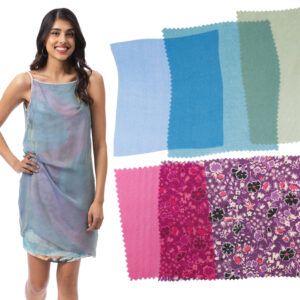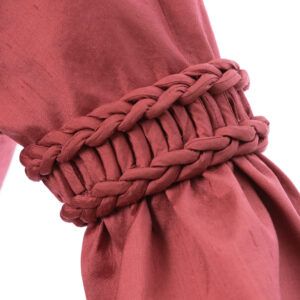I’m participating in a community quilt-making project. Each participant will make a 12 1/2 inch square, crazy-quilt style, choosing a single color for each square, as many prints or solids in that chosen color as desired. We will embellish the piece-worked square with embroidery on the seams or elsewhere, also using beads, buttons, laces, etc. to complete the square. The squares will be joined “on point”, with squares of a mottled dark blue intervening the crazy squares on the diagonal. The fabrics will all be cotton or other relatively light-weight fabrics.
I think crazy-quilts are made with randomly shaped and sized pieces of fabric, but that’s about all I know. My question is: are there any rules at all for placing the pieces? Someone once told me that the pieces are not just placed randomly, at least traditionally. Is that so? Also, should the pieces have straight edges only? I’ve obviously never quilted before, but I’m looking forward to this. Any help, warnings, suggestions, would be welcome.



























Replies
I don't think there are any rules. Check out this site for some ideas. http://www.nmia.com/~mgdesign/qor/styles/crazy/crzayqlt.htm
Thank you Jean. The stitching suggestions at this site are helpful. Joan
I don't know if the pieces are actually random, although the crazy quilts I've seen tend to be. I do know that they also usually have straight edges, simply because it's a whole lot easier to sew them when the seams are straight. The only time I've done crazy quilting was by machine, and with a foundation fabric onto which the fabrics were sewn. Are you going to be using a foundation? It's not essential, I found it helpful.
The process is a lot of fun--much different from the usual plan-ahead-then-curse routine that a lot of my sewing follows!
Carol
I think I will use a foundation--I've been looking at a book that describes the process, and it does seem easier. And yes, straight edges are much more my speed. Thank you for your help. I do think this group quilt will be fun.When you made your crazy quilt with foundation, were the pieces printed on the foundation material, or did you draw your own shapes?
Edited 8/29/2005 10:21 pm ET by Josefly
The shapes weren't printed on the foundation, and I didn't draw them. I just started with a rectangle or square, and folded down one corner randomly, to create a 5-sided shape that wasn't quite a pentagon. I placed this in the center of my foundation, and worked out from it, working my way around the shape. The final effect wasn't really circular, but that's just an easy way to begin--sew a patch to one side of the center patch, then one to the adjacent side, and on around till you get back to the first side, and continue from there.
Carol
Thank you for that description, Carol. I'm not sure how I'll lay out the pieces from a center piece using a foundation, since the foundation method seems to require simple one-seam overlaps, without intersecting pieces/seams. But you've given me a place to start, and maybe it will become clear as I actually lay out the pieces?
Starting from the center, you can do simple overlaps. Just place your 5-sided piece in the middle of the foundation, and pin it down so it doesn't shift around. For the second patch, take a rectangle of fabric and cut it so that one edge is the same length as one side of the center patch. Lay it on top of the center patch, right sides together, with the two matching edges aligned. Sew that seam, flip your second patch right side up, and press. For your third patch, cut another rectangle with one edge the same length as the next side of the center patch, plus the side of the second patch. Lay it, right sides together, on top of the other two, with the matching edges aligned, and sew that seam. Flip it, press it, and continue around the center patch.
I'm not sure if that's clear, but the idea is that each subsequent patch is attached to a straight length of a previous patch's edge, so that you're never sewing anything but a straight seam. The shapes you end up with might look a little random, but the sewing is easy.
Carol
Thank you. That's very clear, and I'm starting to cut and sew. Joan
I've finished piecing my crazy square, and it was great fun. I still have to decide how I want to embellish the seams, so that'll be more fun, but I wanted to thank you for your clear directions. I think I'll do some more of this. Joan.
By the time I saw this thread you had already completed your square! Congratulations. Just a small hint for future reference - I don't think anyone else mentioned this. When you cut your foundation, cut it a little larger than your required finsihed size and then trim it to size when finished. All that seaming can alter the size/shape a little across the block. BevA
Yes. I made the foundation l3 inches for a 12 1/2 inch finished square, and you're right, it drew up in funny ways, and isn't square, but I think I can trim it to the right size and shape. Not sure, though...I may have to add some extra fabric somehow. Next time I'll make it a full inch larger. I'm told that adding embroidery to the seams will probably shrink it more. Live and learn.
Standard "plan" is to start with a piece of fabric with an odd number of sides in more or less the middle of your backing square. (In your case, a 12-1/2" piece of muslin) Then add pieces around, in whatever colors and fabrics look good, until your backing is filled. Then embroider and embellish to your hearts content! The website that was given you looks good, but you don't really need to buy patterns for this!
you can also start with 12 x 15" squares and cut them in a sequence and sew them back together, you end up with a nine patch distorted within the 15" square with each of the 9 a differnt fabric, quick and easy to do. If you want exact instructions send me an email to my normal email address and i can then forward the full instuctions with a template [email protected]
This post is archived.